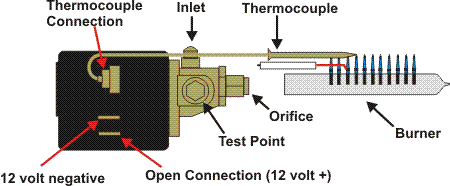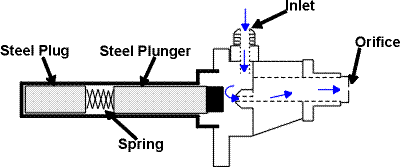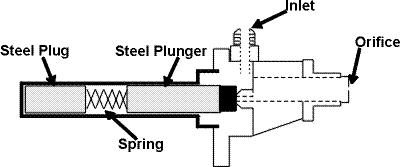Dave's Place
Thermoelectric Solenoid Valve
Before working with the propane system, visit the Gas Safety page.

The thermoelectric solenoid valve is a gas safety device that is opened and closed by 12 volt power, yet is kept in the open position by millivolts generated by a thermocouple. This device is used only on RV refrigerators controlled by circuit boards, and to date has only been used on Dometic refrigerators.
The thermoelectric solenoid valve consists of two main parts; the electromagnet block (black above) and the brass valve body. The electromagnet block has three connections on it; two spade terminals (+ and -), and the thermocouple connection.

How it works
When 12 volt is applied to the "open" connection, an electromagnet winding in the electromagnet block is
activated and pulls a steel plunger back inside the valve body (see drawing at right, electromagnet block removed).
This allows propane to flow from the inlet through the valve and out the orifice, where it is ignited
at the burner. About 10 to 20 seconds after the burner is lit, the circuit board terminates the 12 volt
power to the "open" connection of the thermoelectric solenoid valve. By this time, the thermocouple
will have been sufficiently heated to generate enough millivolts to allow the electromagnet to hold
the plunger open and allow the flow of propane to continue.
If the flame were to go out, and for some reason could not be relit, the thermocouple would cool and quit generating millivolts. At this point, the plunger would snap forward and shut off the flow of propane for safety.

When it is time for the burner to shut down, a momentary pulse of negative 12 volt is applied to the "open" connection, which shorts out the thermocouple millivolts and causes the plunger to snap forward and shut off the flow of propane (see below). This style of gas control does not use a high and low flame; it is either on or off.
Troubleshooting
FIRST, disconnect the molded plug from the "open" and "12 volt negative" connectors on the thermoelectric
solenoid valve before doing any tests that involve applying 12 volt to the connections or measuring
resistance across the terminals. Failure to do so will most assuredly damage the circuit board.

If you suspect a problem with the thermoelectric solenoid valve, connect a jumper wire from the main positive (+) connection of the refrigerator to the "open" connection of the thermoelectric solenoid valve (after following the instructions in the paragraph above). You should hear the plunger inside click open, indicating that the valve is working correctly. If the valve doesn't open with this test, it is bad and needs to be replaced. If the valve doesn't close for any reason, when it is supposed to, also replace it. For safety reasons, the thermoelectric solenoid valve is not considered repairable. Although the thermoelectric solenoid valve consists of two easily separated main components, it is unfortunately sold only as a single part. See Update below.
This test could also be used to light the refrigerator, if it were inoperable for some other reason. Apply 12 volt to the "open" connection (after disconnecting the molded plug) and hold a lit match to the burner. After the flame has been lit for about 10 seconds, release the 12 volt power to the "open" connection. The thermocouple will take over, the flame should stay lit, and the safety mechanism will be fully functional. Of course there will be no thermostatic control of the flame and everything will eventually freeze, but this may be better than the alternative.
If you have a situation where the flame lights for about 10 seconds and then drops out; you probably have a problem with the thermocouple. Check the thermocouple connection at the thermoelectric solenoid valve. Go so far as to unscrew the thermocouple from the connection and clean it and the connector. When reconnecting the thermocouple, be sure it's snug, but do not over tighten. Also be sure the thermocouple is situated properly in the burner flame. Although there is a slight possibility that the thermoelectric solenoid valve could be the defective part in this situation, the only logical thing to do if checking the thermocouple doesn't solve the problem, is to replace the thermocouple, because of the vast difference in price between it and the thermoelectric solenoid valve. If that doesn't do the trick, then replace the thermoelectric solenoid valve.
Update
The thermoelectric solenoid valve is no longer available. If it is bad you'll need to get a
Dometic conversion kit, which consists of a different solenoid and circuit board. If you have
recently replaced your circuit board with a Dinosaur brand P-1338 (Rev. 5), you can purchase
just the new gas valve and use the wire pig tail that came with the board to control the valve.
Dometic AES System
RV Refrigerator Home
This RV refridgerator information was originally located on rvmobile.comRV Mobile Inc. 11715 HWY 99, Everett, WA 98204
The owner of RV Mobile Inc. apparently suffered a heart attack and the original website was shut down.
It has been reposted here to preserve this wealth of information RV refridgerator information.